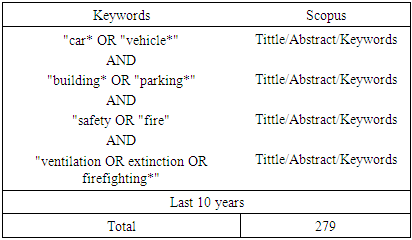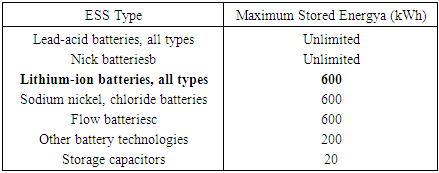-
Paper Information
- Paper Submission
-
Journal Information
- About This Journal
- Editorial Board
- Current Issue
- Archive
- Author Guidelines
- Contact Us
Architecture Research
p-ISSN: 2168-507X e-ISSN: 2168-5088
2022; 12(1): 1-11
doi:10.5923/j.arch.20221201.01
Received: Dec. 30, 2021; Accepted: Jan. 21, 2022; Published: Feb. 15, 2022

From Combustion Vehicle to Electric Vehicle Parking, Through a Review of Legislation and Publications
M. Blanco-Muruzábal1, C. Martín-Gómez1, A. Zuazua-Ros1, T. Trabada Echarri1, J. Valdivieso de las Heras1, N. Mambrilla-Herrero2
1Universidad de Navarra, Department of Construction, Building Services and Structures, Pamplona, Spain
2Arup Australia
Correspondence to: C. Martín-Gómez, Universidad de Navarra, Department of Construction, Building Services and Structures, Pamplona, Spain.
| Email: |  |
Copyright © 2022 The Author(s). Published by Scientific & Academic Publishing.
This work is licensed under the Creative Commons Attribution International License (CC BY).
http://creativecommons.org/licenses/by/4.0/

Electric mobility is expected to increase in the following years motivated by environmental awareness and government targets, therefore, a great number of combustion engines cars will be replaced by electric ones. In addition, urban space has become scarcer to house a large number of existing vehicles increasing the number of underground parking. Like cars remain parked here most time of the day being charged, new elements appear, so this transition requires parking infrastructures to match. But, are the millions of underground existing parking ready for it? Given the shortage of regulations and the existing debate, the integration of the systems is not undertaken safely. In this context, this paper seeks to analyze the level of preparation of underground parking through scientific literature and a review of standards detecting conditions and requirements to prevent possible hazards. Although the article is focused on the Spanish context, the detected problems, hypothesis and proposal of solutions can be applied to other countries.
Keywords: Vehicle, Building, Parking, Safety, Risk, Extinction
Cite this paper: M. Blanco-Muruzábal, C. Martín-Gómez, A. Zuazua-Ros, T. Trabada Echarri, J. Valdivieso de las Heras, N. Mambrilla-Herrero, From Combustion Vehicle to Electric Vehicle Parking, Through a Review of Legislation and Publications, Architecture Research, Vol. 12 No. 1, 2022, pp. 1-11. doi: 10.5923/j.arch.20221201.01.
Article Outline
1. Introduction
- Nowadays the dependence on cars as a means of transport is still a concern. Improvements in road transport and the urbanization of the periphery of cities have led to an increase in this dependency (Paul Rodrigue, 2020). Consequently, the use of cars is presented as one of the largest sources of emission of greenhouse gases GHG in the European Union. Almost 72% of total GHG transport emissions were attributed to overland transport in 2017, of which 44% corresponded to passenger cars (EEA, 2019).For many years, numerous countries have been trying to set targets to gradually ban conventional combustion vehicles and stimulate interest in electric ones in an attempt to achieve significant reductions in emissions (European Environment Agency, 2019). This reduction has been achieved through tax incentives, grants, and funding (Selvey, 2018), restricting cars in some parts of cities and the promotion of public transport (Rezvani, Jansson & Bodin, 2015).Measures to reduce the impact of the sector are sought through electric mobility, as this type of vehicle guarantees the reduction of the emissions of air polluting gases (Niestadt & Bjørnåvold, 2019).Electric cars use a Battery Energy Storage System (BESS), of which there is a wide variety on the market. However, the batteries most commonly used in electric cars (EVs) are lithium-ion ones (Dawson, Bloomberg, & Getty, 2018). The use of this technology implies changing the way cars are refueled (Mingardo, van Wee, & Rye, 2015). This transition from conventional combustion vehicles to electric ones represents a challenge that currently remains unresolved. The present study arose as a result of this issue, aiming to assess the level of preparation of underground parking concerning the aforementioned transition. In the future, a large number of parking spaces would have to be retrofitted to cater for electric cars, since at least two off-street and two on-street parking spaces are necessary for each electric car in a motorized city (Paul Rodrigue, 2020). Parking infrastructures may have to be converted into a type of container of numerous systems that make use of the electricity grid of the buildings in which they are located. With this comes the risk that if the infrastructure is not adequately designed, charging points are likely to increase a building´s electrical load (Selvey, 2018). It is, therefore, necessary to consider specific conditions to mitigate the potential hazards.
1.1. Objectives
- Among the numerous EVs are trains, buses, motorbikes, bikes and the increasingly used electric scooters (Álvarez & Land, 2018). According to AEDIVE, the PNIEC set a target of achieving five million electric vehicles in Spain by the year 2030 (ADIVE, 2020). Most of these are passenger cars and are considered the main field of study of this research. Despite electric mobility being intended to grow at a rapid pace, the incorporation of electric cars requires not only a change in mentality but the adaptation of existing road transport infrastructures. From an architectonical point of view, the close relationship between cars and buildings gives rise to underground parking. This is why the different solutions which shall be proposed all relate to these spaces. The purpose is to assess how prepared the existing infrastructure is so that the transition from combustion to EVs fulfills the same statutory requirements, including those of fire protection and safety standards. However, in terms of safety, it is still unclear how electric cars compare to conventional ones. This lack of real solutions for the implementation led to the creation of an informative framework using different references. An additional objective was to extract the guides and specifications, from different chosen standards, which car batteries would have to meet. This consequently includes where they are housed; the underground parking area. The abovementioned lines of work will allow us to establish the challenges that electric vehicles face today in terms of safety, as well as the prospect of this type of technology in the future.
1.2. Methodology
- Information gathering research was first carried out, in phases. In this process, to gather the background and previous experiences, an analysis of different publications was done through the study of scientific literature (Figure 1).
 | Figure 1. Workflow followed in the article. Source: Drawing by authors |
1.3. Restrictions
- Nowadays, people have become more concerned about the problem of climate change and the effects that the transport sector has on it. For this reason, many countries are encouraging the adoption of electric mobility, whether for public or personal use. However, not all users have a positive attitude towards them, which means that growth is slower than expected (Biresselioglu, Demirbag Kaplan, & Yilmaz, 2018). Another problem that has been detected is that of the electrical requirements and fire safety plans actuation of electric vehicles, which are constantly being debated (Egelhaaf, Wolpert, & Lange, 2014). It is suggested that certain reasons, including the above, may contribute to the limitations of the widespread adoption of electric vehicles and can be classified into different categories.A. Initial investment. It is known that the investment for the purchase of an electric vehicle involves a higher cost than for fuel vehicles at first, and it is from this moment that opposing perspectives arise. On the one hand, those who believe that the initial expense is covered by the fuel savings during its useable life and on the other hand, those who remain skeptical, as not all consumers are awarded by incentive programs concerning electric mobility (Biresselioglu et al., 2018).B. Unconsolidated network of charging points. Even though the public network of recharging points is slowly increasing in Europe to allow free and flexible mobility (Foundation & McKinsey & Company, 2014), the daily routine of an electric car owner will probably lead him or her to load the vehicle either at their home or at the workplace, involving in many cases, underground infrastructures (Selvey, 2018).C. Technical features. This new infrastructure often involves placing a bigger load on the electric grid that in some areas of cities is sometimes under pressure (Niestadt & Bjørnåvold, 2019). It is now believed that the load on many buildings is not large enough to allow the simultaneous charge of many vehicles at once. Another important consideration is the lack of supervision during the moment of loading the vehicle. D. Heated debate. The problem with lithium-ion batteries is that "while highly beneficial, also come with some unique hazards" (O’Connor, 2020). When they are damaged a lot of heat is generated, toxic and flammable gases are emitted, thermal runway between battery cells can cause fire or explosion, and even when the fire is extinguished, a reignition could occur (O’Connor, 2020). This is the reason why rescue personnel must be made aware of it (Egelhaaf et al., 2014). When a fire occurs, the ESS involved is difficult to control (O’Connor, 2020), which leads to an existing debate about the best procedure for action, which increases in part due to confusing published knowledge guides (Egelhaaf et al., 2014).E. Lack of regulation. Related to this, the biggest drawback is that currently there is no formal legislation to regulate the problem of safety protection in electric parking lots. Without compulsory measures, the risk is a reality, as the number of electric vehicles increases but without an installation that guarantees correct functioning in terms of fire protection. The present study consequently aims to explain this.
2. Context and State of the Art
- There is currently no consolidated regulatory framework for electric cars covering all areas to avoid possible hazards involving ESS. Moreover, the EC already passed in 2018 a directive that among other objectives, aimed to foster the development of the demand for EV´s. The Energy Performance Buildings Directive establishes guidelines that only relate to charging infrastructures, citing the different criteria between new and existing buildings (European Commission, 2019).
|
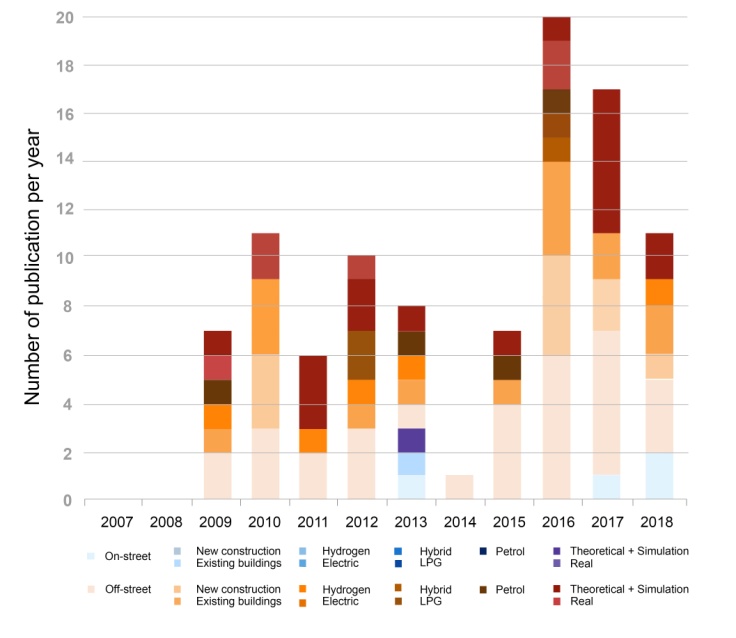 | Figure 2. Several publications per year among the same subcategories of scientific literature classification are in Table.1. Source: Drawing by authors |
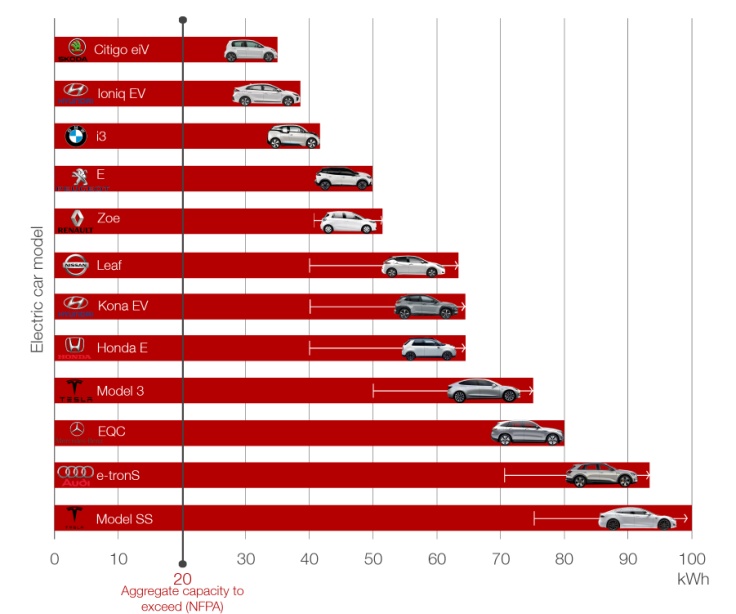 | Figure 3. Study of aggregate capacity through the comparison of different car models. Source: Drawing by authors |
|
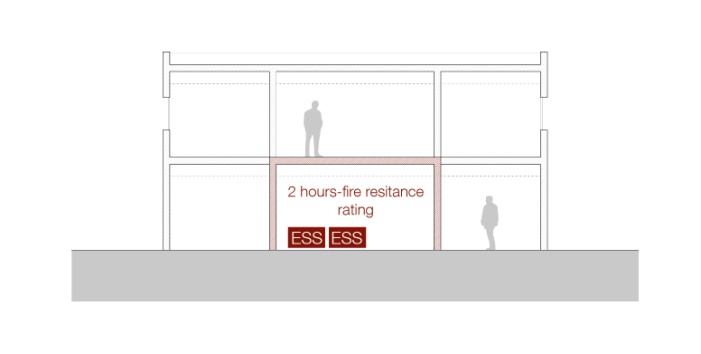 | Figure 4. Conditions to fulfill in terms of interior spread and compartmentalization of spaces containing ESS. Source: Drawing by authors |
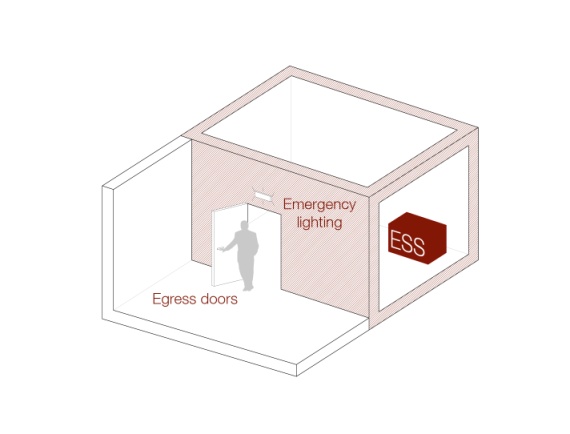 | Figure 5. Requirements in areas or spaces containing ESS. Source: Drawing by authors |
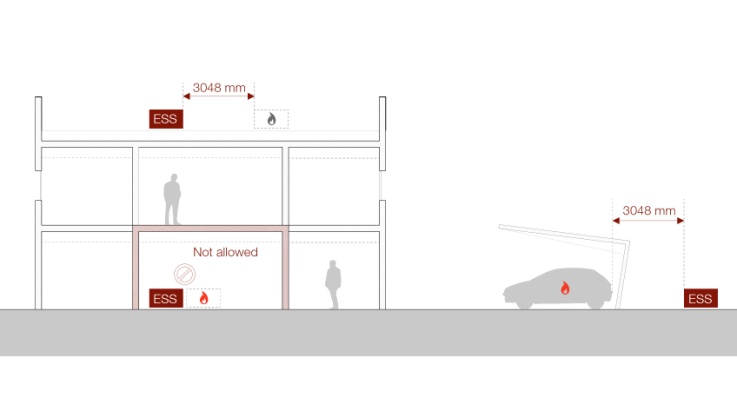 | Figure 6. The maximum permitted distance between ESS and combustible materials. Source: Drawing by authors |
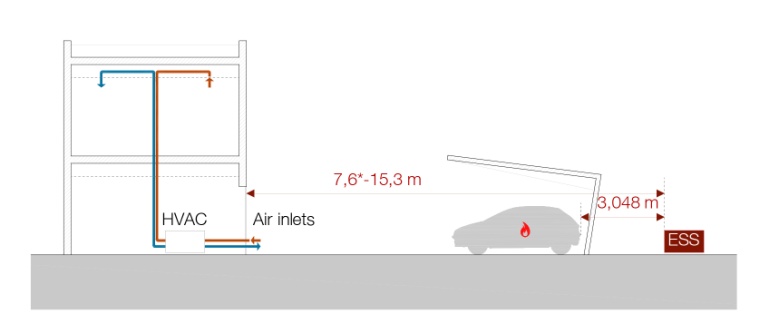 | Figure 7. The maximum permitted distance between ESS and building air inlets (referring to those that lead the entrance of air to both inside the building and other premises). Source: Drawing by authors |
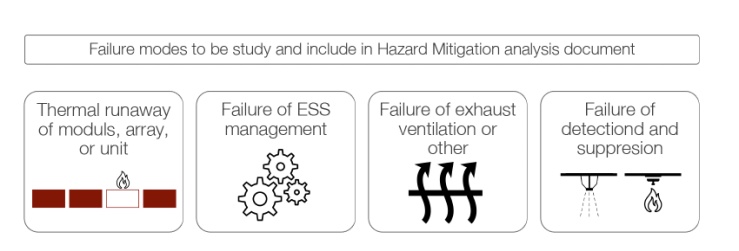 | Figure 8. The study of the different modes of failure to be included in the Hazard Mitigation analysis. Source: Chapter 4, NFPA 855/2020 standard. Drawing by authors |
3. Existing Alternatives
3.1. Data Presentation
- As mentioned before, in Spain there is a suggested lack of appropriate knowledge and policies about the safety criteria of electrical cars. This often results in an unsuitable installation that could entail great risks. When talking about underground parking this is even more important. Another scenario arises within this context; that of applying other criteria to the underground parking areas of residential buildings in Spain. The objective of the data is to analyze what would happen if the NFPA criteria were to be adopted.
 | Figure 9. Several restrictions that electric mobility has to overcome. Source: Drawing by authors |
3.1.1. Active Measures
- In Spanish residential buildings, the typical scheme includes parking spaces that are often located underground. Among other minor uses, there is a mixed-use ground floor and residential use on elevated floors. With the introduction of electric cars, the ESS are now located in underground parking areas which form part of buildings. According to NFPA 855/2020 section 4.3.9, "the ESS located under the finished floor of the lowest level of exit discharge shall not be permitted unless the location is approved by the AHJ".
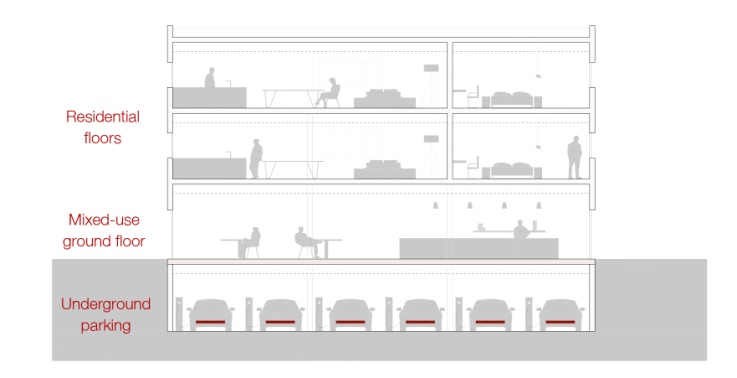 | Figure 10. EVs introduction in the typical scheme of residential buildings in Spain. Source: Drawing by authors |
3.1.2. Passive Strategies
- To prevent the interior spread of fire from one space in the building to another, compartmentation plays a fundamental role, and this is also applicable to residential buildings. Firstly, the NFPA standard states that a two-hour rating must be achieved in walls and ceilings containing ESS. Therefore, as we are analyzing the Spanish case, this condition is compared to the existing one at the DB SI from the Spanish Building Code CTE, which states that spaces intended to house car parks should be considered a risk sector of their own.
 | Figure 11. Comparison between NFPA and CTE standards concerning interior fire spread. Also included is the final result of the application of both regulations. Source: Drawing by authors |
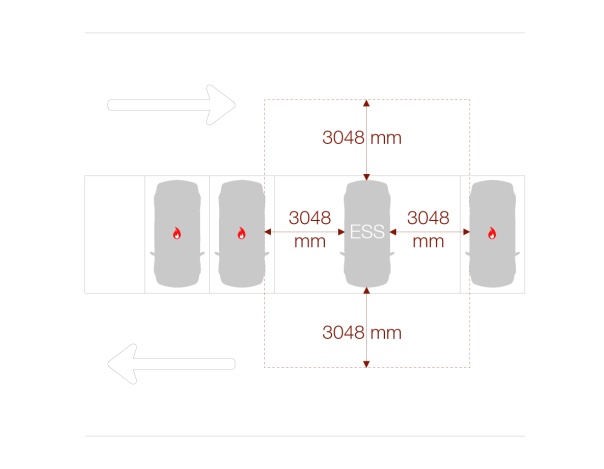 | Figure 12. Scheme for indicating the minimum required distance between combustion and electric cars. Source: Drawing by authors |
3.1.3. Maintenance
- To avoid possible hazards, protect the occupants of buildings and create a safe and healthy environment, maintenance is the key. However, this is not always carried out as often as it should be. Moreover, on a national level, the ITC-BT 52 regulates the connections of electric cars but does not offer specific details on this topic. In this sense, the NFPA standard provides a highly demanding maintenance parameter. This led us to the belief that knowledge-based parameters and conditions should also be applied in Spain. As indicated, a series of documents shall be presented to establish guidance and emergency actuation methods for qualified personnel, including firefighters. As a consequence of this, Spanish buildings would have to incorporate the following reports to the already required ones: Emergency planning and training and an emergency operation plan with the shutdown, de-energizing, or insolation of equipment and systems under emergency conditions.
3.2. Evaluation
- Once the needs and requirements that parking areas in residential buildings should include are established, this section intends to analyze, in general terms, the impact of the above hypotheses in technical, economic, and operative terms.
3.2.1. Technical Feasibility
- - Active measures: A series of different active measures should be included in residential underground parking areas to achieve more consolidated safety criteria. In the present day, the majority are available on the market but on the subject of specific EVs requirements, not all have the same effect as for the previous use. This is the case of fire detection and suppression systems, for example.- Passive strategies: The techniques and processes are known and therefore possible to implement. That said, a separation between types of cars would be necessary. - Maintenance: This point refers to the possibility of including new documents in Spanish building legislation. Standards are under constant revision and changes could be made if necessary. According to the NFPA, some processes and tests must be included to provide adequate information about the cars located in a residential parking space. In this way, if a fire occurred, the data would be available and could be provided to emergency teams such as firefighters or qualified personnel.
3.2.2. Economic Feasibility
- - Active measures: To achieve the best solutions to increase the safety conditions in underground parking, new installations will be needed in some cases. For example, this is the case with sprinklers. Not all residential existing parking areas have this type of suppression system therefore an adaptation of the facilities should be carried out if necessary. The same applies, for example, to the installation of thermographic cameras or with processes to prevent the thermal runaway and explosions of batteries. The inhabitants of the building would have to take on the new expenses and if this were the case of a newly constructed residential building, it could strongly influence the budget, and therefore the purchase price.- Passive: Adopting the explained passive strategies would not represent a large economic outlay in comparison to the current budgets of residential parking for combustion vehicles. However, if we talk about size and separation distances, a major parking space would be needed for EVs until conventional combustion vehicles disappear completely. As they will have to share location for many years, an established distance would be needed between them. This would result in a smaller number of parking spaces.- Maintenance: The different fire tests, analyses and changes in documentation represent an added economic outlay. This may be reflected in a higher selling price of underground parking spaces in the case of a newly constructed building.
3.2.3. Operative Feasibility
- - Active measures: A proposed requirement is to have a load management system of the batteries of the EVs, in this way possible hazards could be prevented and kept under control. Nevertheless, there are no available standards for manufacturers to provide an interface or a method of "monitored alarm system within the building"(National Fire Protection Association, 2020). With regard to exhaust ventilation, the NFPA standard does not establish its obligation, but states that ventilation during suppression is the key (National Fire Protection Association, 2020), and as many Spanish residential buildings have this type of ventilation system, the safety criteria is reinforced. Additionally, in the underground parking areas of residential buildings, detection must also be included. It must be said that some requirements are difficult to achieve at this time. For example, methods to neutralize spills are technically complicated and must be carried out by qualified personnel. In this sense it seems unlikely that it could become a normal practice in these building spaces. Other suppression agents could be used for suppressing batteries fire. However, there is a lack of appropriate knowledge on this matter.- Passive: Firstly, there is one group of requirements that in Spain does not currently involve changing design, processes and materials. This is the case of hour-rate resistance of enclosures, egress routes and doors and lighting. There are however, some points that can affect underground parking in operative terms, such as the need for a distance of separation. Applying a minimum distance between both combustion and electric vehicles means that a smaller number of parking spaces could be organized inside a residential underground parking lot. This is a very important aspect which would need to be studied with greater consideration in the future.- Maintenance: The adoption of the requested documentation, for delivering it to the concerned authorities and for it to be consequently organized by the emergency personnel, would affect building safety protocols. This would involve making several changes and readapting the existing standards. However, this would also involve testing, training of qualified personnel and various activities already identified, which for an existing building may prove difficult to adopt. If we apply this to residential buildings, a qualified person should regulate EVs in underground parking. This is a complicated issue since the availability of 24-hour surveillance staff would entail significant cost and in turn be difficult to implement due to the large number of buildings with underground parking in Spain. Other authors make reference to load management systems in order to dispense with the suggested staff, but further development is needed in this field of study, as is also indicated in the NFPA standard.
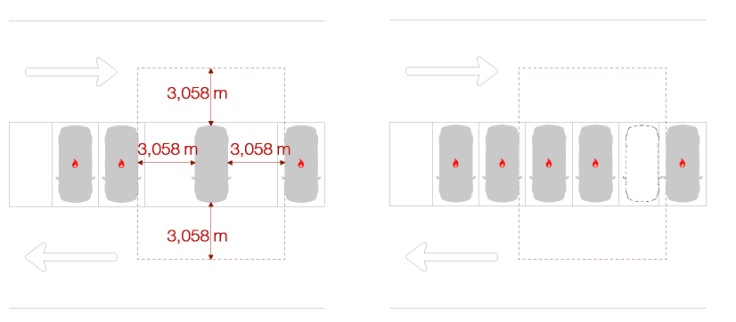 | Figure 13. Comparison between the new situation (applying a distance of separation) and the previous one. Source: Drawing by authors |
4. Discussion and Conclusions
- Background evidence proves that electric transport transition is a reality in 2020. However, there are still many unknown aspects and society does not seem well prepared for it. With uneven development between different parts of the world, electric mobility faces a challenge. With the introduction of electric cars, these spaces were analyzed in this study to establish the current level of preparation of these infrastructures within the car transition. Firstly, this work analyzes and classifies the existing scientific literature related to this transition over the last ten years. It is worth noting that this literature review demonstrates that only a few publications consider the safety of on-street parking. Therefore, future research on this topic will be necessary in order to achieve equal safety criteria. In the same way, it is important to highlight those studies involving real experiences are fewer than the ones that remain at a theoretical level. Few scale prototypes have been developed in underground parking areas and even less in residential buildings. As a result, this type of mobility needs to be developed further and some of the main improvements should be carried out taking the following points into consideration:- The analysis of the proposed scenario, the adoption of the American criteria by the Spanish residential underground parking, determines that the implementation of several new conditions is possible. However, it appears that the European Union could make an effort to adapt and evaluate the consequences of incorporating some of the mentioned terms.- Spanish legislation regarding electric cars does not mention any safety of maintenance activities. According to the NFPA, the standard maintenance of ESS is a key point. By adopting different required documents and conditions, the possible hazards involving electric cars batteries could be reduced.- Future solutions must also be oriented towards creating valuable and testable performance guides for qualified personnel and firefighters. Confusing knowledge and heated debate has sometimes led to actions that may not be the correct ones.Focusing on its progressive increase, it should be noted that other obstacles are likely to appear in the future. The transport sector is not currently experiencing a massification of electric vehicles, but if this does occur, certain questions could compromise this type of mobility. Aspects to consider include the following:- Several studies remark that charging stations need a major boost, not only concerning their location through the road network but also their integration in buildings. The current practice in car parks is to install a reduced number of large charging points. To ensure that buildings can cope with this extra load, some authors discuss the necessity of developing load management systems and battery storage technology (Selvey, 2018).- Although the present study has been proposed from the Spanish perspective, it is evident that the possibilities described are valid for other countries experiencing similar situations.How governments, manufacturers and building designers deal with these questions, as well as with the necessity of safety criteria in buildings, will prove to be the ultimate step towards achieving a fully global electric transition.
References
| [1] | ADIVE. (2020), “El Gobierno confirma que la movilidad eléctrica sigue siendo una prioridad y revela novedades del MOVES2020”. Retrieved April 27, 2020. [Online]. Available: https://aedive.es/gobierno-confirma-movilidad-electrica-prioridad-novedades-moves2020/. |
| [2] | M. B. Álvarez and A. D. Cremades, “¿Es el patinete eléctrico un ciclomotor? Luces y sombras ante un limbo jurídico”, pp. 1-6, Aug. 2018. |
| [3] | M. E. Biresselioglu, M. Demirbag Kaplan and B. K. Yilmaz, Electric mobility in Europe: A comprehensive review of motivators and barriers in decision making processes. Transportation Research Part A: Policy and Practice, vol. 109, pp. 1–13, 2018. [Online]. Available: https://doi.org/10.1016/j.tra.2018.01.017. |
| [4] | Comité Técnico AEN/CTN 23. UNE-EN 12845:2016, “Sistemas fijos de lucha contra incendios. Sistemas de rociadores automáticos. Diseño, instalación y mantenimiento”. Oct. 2016. |
| [5] | CTE. Documento Básico SI Seguridad en caso de incendio, Dec. 27, 2019. [Online]. Available: http://www.arquitectura-tecnica.com/hit/Hit2016-2/DBHE.pdf. |
| [6] | CTE. (2019b). Documento Básico SUA Seguridad de utilización y accesibilidad. pp. 1-47, Dec. 27. [Online]. Available: http://www.arquitectura-tecnica.com/hit/Hit2016-2/DBHE.pdf. |
| [7] | S. Dawson, Bloomberg and Getty, Ten years left to redesign lithium-ion batteries. Nature, vol. 559, pp. 467–470, 2018. [Online]. Available: https://www.nature.com/articles/d41586-018-05752-3/. |
| [8] | Diabatix, Thermal runaway: Li-on battery safety through better heat sink design. 2019. Retrieved May. 14, 2020. [Online]. Available: https://www.diabatix.com/en/blog/prevent-thermal-runaway. |
| [9] | EEA, Greenhouse gas emissions from transport in Europe. European Environmental Agency (EEA). 2019. [Online]. Available: http://33h.co/kngqx. |
| [10] | M. Egelhaaf, D. Wolpert and T. Lange, Fire Fighting of Battery Electric Vehicle Fires. In Third International Conference on Fire in Vehicles, pp. 221–230, 2014. |
| [11] | European Commission. (2019). Commission Recommendation (EU) 2019/1019 of 7 June 2019 on building modernization. Official Journal of the European Union., 6(L127), pp. 34–79. |
| [12] | European Environment Agency, Progress of EU transport sector towards its environment and climate objectives. Transport and Environment Reporting Mechanism (TERM) Progress, pp. 1–13, 2018. [Online]. Available: https://doi.org/10.2800/139739. |
| [13] | European Environment Agency, Fiscal instruments favouring electric over conventional cars are greener. Manufacturing Engineering, vol. 161, 2019. [Online]. Available: https://doi.org/10.2800/012149. |
| [14] | A. R. Foundation, McKinsey, and Company, Electric vehicles in Europe: gearing up for a new phase?, 2014. |
| [15] | R. T. Long, A. F. Blum, T. J. Bress, and B. R. T. Cotts, Best Practices for Emergency Response to Incidents Involving Electric Vehicles Battery Hazards: A Report on Full-Scale Testing Results. The Fire Protection Research Foundation, NFPA, vol. 110, Jun. 2013. |
| [16] | C. Martín-Gómez, J. Bermejo-Busto and A. Zuazua-Ros, Del biomorfismo a las células Peltier: experiencias en la investigación arquitectónica extrapolables al ámbito de la Defensa. In III Congreso Nacional de i+d en Defensa y Seguridad. Centro Universitario de la Defensa de Marín, Escuela Naval Militar, 2015. |
| [17] | G. Mingardo, B. van Wee, and T. Rye, Urban parking policy in Europe: A conceptualization of past and possible future trends. Transportation Research Part A: Policy and Practice, vol. 74, pp 268–281, 2015. [Online]. Available: https://doi.org/10.1016/j.tra.2015.02.005. |
| [18] | National Fire Protection Association, Standard for the Installation of Stationary Energy Storage Systems NFPA 855, 2020. |
| [19] | NFPA, Emergency Field Guide for hybrid, electric, fuel cell and gaseous fuel vehicles. Quincy, Massachusetts, 2018. [Online]. Available: https://doi.org/978-1455912742. |
| [20] | M. Niestadt, and A. Bjørnåvold, Electric road vehicles in the European Union Trends, impacts and policies. EPRS | European Parliamentary Research Service, Apr. 11, 2019. [Online]. Available: http://www.europarl.europa.eu/RegData/etudes/BRIE/2019/637895/EPRS_BRI(2019)637895_EN.pdf. |
| [21] | B. O’Connor, B, NFPA 855 and sprinkler protection for energy storage systems. NFPA Journal, (Sprinklers and ESS), 2020. [Online]. Available: http://33h.co/kngqd. |
| [22] | J. Paul Rodrigue, The Geography of Transport Systems, 5th ed., New York, 2020. |
| [23] | REBT, Reglamento Electrotécnico para Baja Tensión e ITC, 2019. |
| [24] | Z. Rezvani, J, Jansson, and J. Bodin, Advances in consumer electric vehicle adoption research: A review and research agenda. Transportation Research Part D: Transport and Environment, vol. 34, pp. 122–136, 2015. [Online]. Available: https://doi.org/10.1016/j.trd.2014.10.010. |
| [25] | A. Selvey, Out of juice? CIBSE JOURNAL, JULY (ELECTRIC VEHICLES), pp. 28–30, 2018. [Online]. Available: www.cibsejournal.com. |
| [26] | H. Vikström, S. Davidsson, and M. Höök, Lithium availability and future production outlooks. Applied Energy, vol. 110, pp. 252–266, 2013. [Online]. Available: https://doi.org/10.1016/j.apenergy.2013.04.005. |
| [27] | A. Zuazua-Ros, C. Martín-Gómez, E. Ibañez-Puy, M. Vidaurre-Arbizu, and Y. Gelbstein, Investigation of the thermoelectric potential for heating, cooling and ventilation in buildings: Characterization options and applications. Renewable Energy, vol. 131, pp. 229–239, 2019. [Online]. Available: https://doi.org/10.1016/j.renene.2018.07.027. |
 Abstract
Abstract Reference
Reference Full-Text PDF
Full-Text PDF Full-text HTML
Full-text HTML
